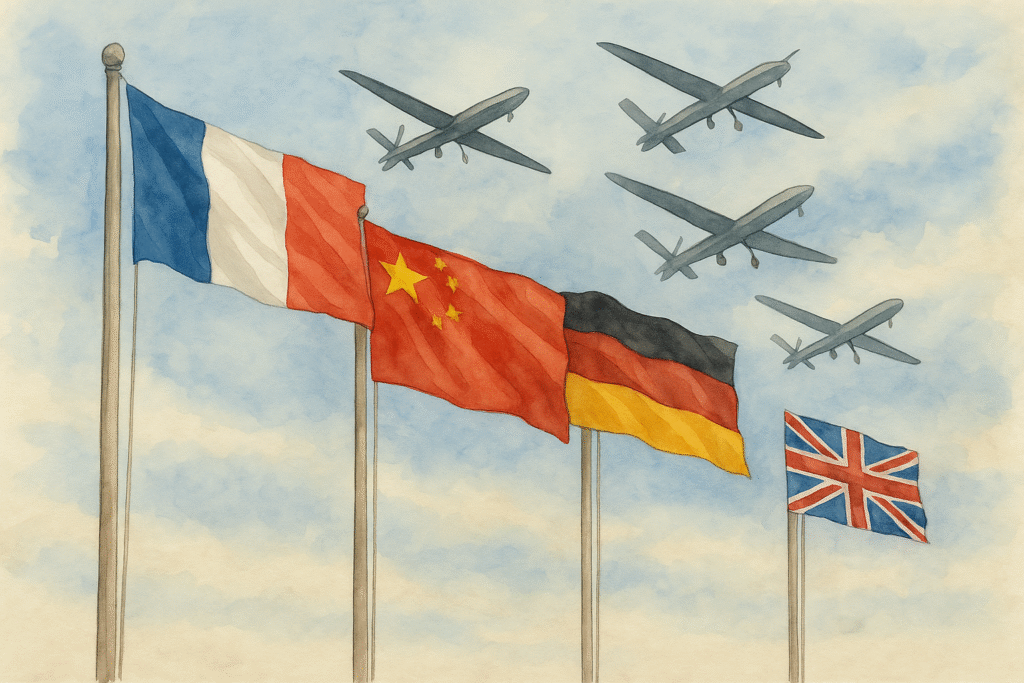AI and Modern Warfare: How Other Countries Are Following Ukraine’s Steps

AI in modern warfare is no longer a futuristic vision—it’s a present reality. What began as a strategic innovation in Ukraine’s defense against Russia has rapidly expanded to influence the global defense landscape. From autonomous drones to battlefield analytics, artificial intelligence is reshaping military operations with precision, speed, and ethical dilemmas. But how exactly are other nations adapting to this new era of combat? This article explores the implications, technologies, and global shifts surrounding AI in warfare.
Ukraine: The First Major AI-Enhanced Battlefield
Ukraine’s use of artificial intelligence in warfare marked a turning point. During the war against Russia, Ukrainian forces implemented real-time AI-powered systems for surveillance, drone coordination, cyber defense, and targeting logistics. These technologies weren’t just experimental—they were deployed actively, with substantial effectiveness.
The most notable tools included AI-enhanced satellite imaging, autonomous drones for reconnaissance and attack, and software that predicted enemy movements using big data analytics. This advanced ecosystem turned the war into a data-driven battlefield—an approach later adopted and studied by military strategists worldwide.
The Ukrainian model of integrating commercial tech startups, military intelligence, and foreign support from companies like Palantir set a precedent for future conflicts. AI in modern warfare became synonymous with agility, adaptability, and tech-driven sovereignty.
How the U.S. Is Scaling AI for Military Use
The United States has long invested in military AI through agencies like DARPA and the Department of Defense. But recent years saw an acceleration inspired by Ukraine’s application of AI. The Pentagon launched programs to increase battlefield automation, predictive analytics for logistics, and AI-assisted decision-making in combat scenarios.
One major example is Project Maven—an AI program aimed at interpreting video footage from drones faster than human analysts. Additionally, the U.S. has been testing autonomous land vehicles, AI-powered missile guidance systems, and war-gaming simulations using reinforcement learning algorithms.
The Department of Defense also emphasized ethical AI use, creating frameworks to govern human-machine interactions in lethal scenarios. While the U.S. possesses significant resources, Ukraine’s example brought urgency and validation to AI integration.
China’s Strategic Push for AI Dominance in Defense
China views artificial intelligence as key to national security and geopolitical dominance. Through its “Military-Civil Fusion” strategy, the Chinese government integrates commercial AI developments into military applications, aiming to surpass the U.S. in both economic and defense AI capabilities by 2030.
China has tested AI systems for drone swarming, facial recognition for battlefield ID, and autonomous submarines. The People’s Liberation Army (PLA) also uses machine learning models for strategic simulations, data analysis, and operational command systems.
Beijing’s investments in quantum AI, space warfare AI, and surveillance networks further underline its ambition. While Ukraine highlighted AI’s practical effectiveness, China focuses on scale, central control, and international deterrence.
Europe’s Cautious but Determined AI Expansion
Several European nations began reviewing and adapting their military AI capabilities post-Ukraine. Countries like France, Germany, and the UK launched strategic AI plans, balancing innovation with compliance to international humanitarian law.
The UK Ministry of Defence has funded projects for AI logistics, battlefield triage, and threat detection. France partnered with domestic startups to explore swarm drones and hybrid AI-cyber operations. Meanwhile, NATO initiated programs to standardize and share AI systems across allied forces.
Europe’s approach is marked by careful ethical oversight, emphasizing transparency, accountability, and explainable AI models to prevent misuse in military operations.
Israel’s Legacy and AI-Driven Defense Systems
Israel has long been a pioneer in military technology and remains at the forefront of AI in modern warfare. The country’s Iron Dome missile defense system already incorporates elements of automation, and recent enhancements rely heavily on AI to optimize interception speed and accuracy.
Israeli defense companies like Rafael and Elbit Systems have developed AI-based surveillance drones, automated target recognition, and cognitive radio systems for complex battlefield environments.
Israel’s real-time battlefield data processing capabilities allow rapid feedback loops, enabling faster and more accurate tactical decisions. The Ukrainian war validated many of these technologies, encouraging further investment and innovation.
The Role of AI in Cyberwarfare and Electronic Conflict
AI is not limited to physical combat—it plays a critical role in cyberwarfare. Modern conflicts involve data manipulation, system infiltration, and information warfare. AI enhances both attack and defense in these domains.
Machine learning models can detect anomalies in real-time, predict breach attempts, and respond automatically. Likewise, offensive AI systems simulate social engineering attacks, identify vulnerabilities, and craft adaptive malware that evolves with defenses.
Ukraine, for instance, used AI-assisted tools to detect phishing campaigns, manage cloud infrastructures under siege, and recover from digital sabotage. Similar tactics are now seen in Taiwan, South Korea, and Baltic states bracing for cyber threats.
AI-Enhanced Drones and Autonomous Weapon Systems
Unmanned systems are becoming the face of AI in modern warfare. Drones, ground robots, and naval drones are now equipped with AI for navigation, targeting, and mission execution. These systems minimize human risk and enable prolonged operations in hostile environments.
Autonomous drones used in Ukraine served as reconnaissance tools and even loitering munitions. Other countries—like Turkey with its Bayraktar drones—quickly scaled similar solutions. The U.S. and China are also testing AI-powered drone swarms capable of coordinated assaults and area surveillance.
Yet, autonomous weapon systems raise ethical debates around accountability, legality, and civilian safety. International treaties may soon need updates to govern this new paradigm.
Risks, Ethics, and the Future of AI in War
With great power comes great responsibility. AI in warfare opens ethical dilemmas: who is accountable if an AI system causes collateral damage? Can machines make moral decisions? How transparent are AI decisions in lethal scenarios?
Ukraine’s experience shows that AI can be a tool of resilience and defense, but unchecked use can also escalate conflicts. Transparency, ethical frameworks, and international regulation are critical.
The future of AI in war will likely involve hybrid teams—human commanders supported by machine advisors. Nations will need to balance innovation with oversight to avoid losing control of their most advanced systems.
What the World Learned from Ukraine
Ukraine’s innovative use of AI in defense inspired global military transformations. The lessons include:
- AI can amplify capabilities without replacing human judgment.
- Speed and adaptability matter more than size.
- Public-private partnerships accelerate innovation.
- Cyber resilience is now a national security priority.
Most importantly, Ukraine demonstrated that small nations can lead technological revolutions in warfare, reshaping geopolitics through strategic use of AI.
Conclusion
The role of AI in modern warfare is just beginning. From Ukraine to China, the United States to Israel, the race for intelligent military systems is transforming global defense. While technology brings precision and innovation, it also demands responsibility, foresight, and collective regulation.
What we do today—how we train, deploy, and govern AI in warfare—will define not only the outcome of future conflicts but the future of humanity itself.
Want to dive deeper into how AI is shaping the world? Explore our articles on future defense technologies and practical applications of AI:
- The Future of Artificial Intelligence
- AI vs. Cancer: How Artificial Intelligence is Changing Diagnosis and Treatment
Subscribe to our newsletter for free downloadable PDFs and the latest AI insights straight to your inbox!
Frequently Asked Questions (FAQ)
- What is AI in modern warfare?
It refers to the use of artificial intelligence technologies in military operations, including surveillance, strategy, weapons, and logistics. - Which country uses AI most in war?
Currently, Ukraine, the U.S., China, and Israel are among the most advanced in military AI adoption. - Can AI replace soldiers?
Not entirely. AI enhances operations but ethical concerns and complexity prevent full replacement of human decision-makers. - Are AI weapons legal?
There’s no global consensus yet. Some nations demand regulation, while others develop these systems actively. - What are the risks of AI in warfare?
Errors, loss of control, ethical issues, and potential escalation of conflicts. - Can AI help prevent wars?
In theory, AI can help predict and prevent conflicts through data analysis, but it can also be used for offensive purposes.



